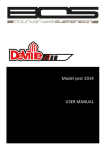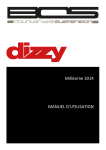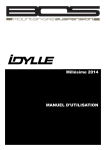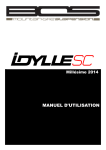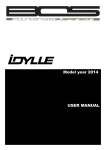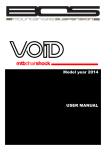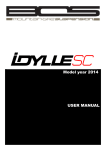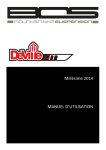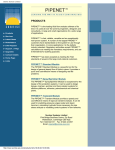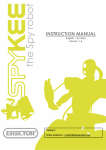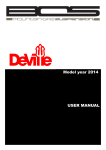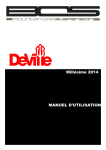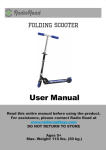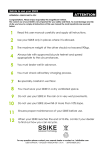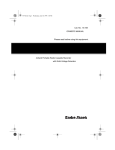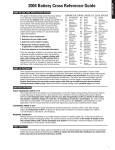Download Model year 2014 USER MANUAL
Transcript
Model year 2014 USER MANUAL WARRANTY Terms and conditions BOS MTB offers warranty on its products on the following terms: BOS MTB guarantees to the original purchaser that the BOS product for which they received this warranty is free from defects in material and workmanship for one year from the date of original retail purchase. A proof a purchase will be asked for any warranty claim. This warranty is not transferable to a subsequent purchaser. Wear and tear parts such as dust seals, Oring, bushings, rear shock mouting hardwares, stanchions, threaded parts and bolts are not covered under this warranty. Terms This warranty is subject to legal jurisdictional or warranty rights of the country where it has been originally purchased, which will prevail if different from the terms herein listed. Limits BOS MTB cannot be liable for any loss, inconvenience damages, whether direct, incidental, consequential, resulting from the use of its products, local legislation prevailing. Warranty exclusions This warranty does not cover the following cases: • Damage to products resulting from improper assembly other than listed below • Products that have been modified by the owner or a third party • Improper use • Damages resulting from an accident, crash under any circumstances • Invalid servicing procedures and servicing time frame not respected • Replacement of the original parts by parts from others manufacturers • Products whose serial numbers has been altered, defaced or removed. Warranty procedure The owner should always refer to an approved BOS center for any warranty claim. A proof a purchase is compulsory for any warranty claim. Otherwise the warranty claim will not be considered. Always contact BOS MTB warranty department before returning any products that may fall under this warranty. If “the faulty parts” do not fall under warranty, the customer will be charged for any costs in respect with warranty such as transport and package back and forth. Settings & Maintenance > > >11 1 . Assembly Fitting your Dizzy onto your bike requires care and attention. For your safety, please follow these instructions. 1.1 The steer tube Before cutting the steer tube, first take some measurements: height of the headset, length of the headtube of the frame, height of the stem, and then add 5 to 10mm. Calculate the length as below: Add the length of the headtube, the height of the headset, the height of the stem, plus 5 to 10mm. Caution : Never attempt to remove or replace the steer independently from the crown. Modifying the integrated crown, steer, or stanchions independently can cause an assembly failure, resulting in a loss of control of the bicycle and serious injury. 1.2 Initial wheel installation and adjustment of axle lever angle During the initial installation of the wheel, it is essential to adjust the angular position of the wheel axle assembly. 1 – Insert your wheel in the lowers. 2 – Insert and tighten the wheel axle. 3 – Break-in the axle by rapidly moving the quick release lever several times between the open and closed position. 4 – When the wheel is properly tightened: If the lever is in its proper position, no further adjustment necessary. If the lever is not in its optimal position, note the angle (A) which must be applied to rotate the axle in position and continue to step 5. 5 – Undo the quick release lever and remove the axle. 6 – Undo and remove the socket head screw (B). 6 – Turn the axle nut the angle observed in step 4 and retighten the socket head screw. 7 – Mount your wheel according to procedure 1.3. A B Optimal lever position Lever out of position Caution: The final position of the lever must not under any circumstances come into contact with the lowers. If necessary, repeat the steps above to refine the lever position. Changing wheels can modify the lever position. Repeat the axle tightening operation each time a new hub is used to assure proper functioning of the axle. 1.3 Installing the 15mm axle To install the front wheel, follow these instructions: 1. Undo the quick release (1). 2. Unscrew the axle to remove it (2). 3. Position the wheel. 4. Insert the axle and tighten it completely. Close the quick release to lock the wheel. (1) (1) (2) (A) Removing the wheel is done by reversing the preceding instructions. 1.4. Disk brake installation The Dizzy uses standard post mount 160 (PM160) mount points. To assemble the disc brakes, follow this procedure: 1. Install the disc brake caliper according to disc brake manufacturer's specifications. 2. Torque all fasteners and bolts to manufacturer's recommendations. Consult the instructions that came with your disc brakes for proper installation procedures. It is recommended to install NEW disc brake pads, to ensure proper alignment and to minimize drag. 3. Route the disc brake hose (for hydraulic disc brakes) or brake cable housing (for mechanical disc brakes) from the caliper to the inside of the lower leg and through the supplied disc brake hose guide. 4. Tighten the disc brake hose guide screw (M3 x 12) with a 2.5 mm-hex key wrench, and torque it to 1 N.m. 5. Test the brakes for proper operation on level ground before hitting the trails. The disc brake caliper mounting bolts must have 10 mm of thread engagement with the fork. Never exceed 10 N.m. of torque when tightening the disc brake caliper mounting bolts. 2. Settings 2.1 Air Spring The first adjustment that should be done on the fork is to set the air pressure. This adjusts the stiffness of the air spring according to your weight. The stiffness of the air spring induces a degree of fork travel when you sit on your bike. This value, commonly called sag, can vary based on your usage. This value should be between 15mm (smooth terrain/climbs) and 20mm (rough terrain/downhills) for the 100mm Dizzy and between 20mm (smooth terrain/climbs) and 25mm (rough terrain/downhills) for the 120mm Dizzy. The sag measurement should be taken with both feet on the pedals and both hands on the bars, arms and legs in the pedaling position. To achieve the best performance from your BOS product, it is important to set your optimal pressure. The chart below will give you some base values based on your weight. Your specific pressure may vary based on your riding style and personal preference. However, do not stray too far from the indicated pressures, or you may risk changing the performance of your fork. Recreational use : Weight (Kg/lbs) 60/132 65/143 70/154 75/165 80/176 85/187 90/198 Air Pressure (PSI) +/-10 PSI 120 130 140 150 160 170 180 Weight (Kg/lbs) 60/132 65/143 70/154 75/165 80/176 85/187 90/198 Air Pressure (PSI) +/-10 PSI 125 135 145 155 165 175 185 Racing use : Caution : Minimum air pressure: 100 PSI Maximum air pressure: 220 PSI psi Air Valve Cap Air Valve Important : Balancing the air chamber pressure: To ensure optimum operation, it is important to balance the positive and negative chambers every time you adjust the air pressure. Proceed as follows: After adjusting the pressure, cycle the fork slowly 3-4 times on the first inch of travel. Thus, the air pressure is distributed equally between the chambers, and your fork is ready to roll! 2.2 Hydraulic adjustments The Dizzy offers suspension adjustments in rebound through a knob and in compression through a lever. Rebound adjustment is done by rotating the red knob that can be found at the bottom of the right fork leg. The number of clicks is counted from the fully closed position while unscrewing the knob. Harder = tighten (close) / Softer = loosen (open) Compression adjustment is done by the position of the red lever at the top of the right fork leg. This lever has three positions. The total possible lever movement is 180°; however, the start position may be offset by an angle of about 20° from vertical, as shown in Figure 1. Figure 1 : Pedaling position H Figure 2 : Intermediate position M Figure 3 : Comfort position S X The three positions are identified as S (soft), M (medium), and H (hard). The two extremes, S and H are reached at the fully open and fully closed positions of the lever. The M position is the click when moving between the S and H position, for fast and intuitive adjustment on the fly. The advantage of BOS’s adjustments is that they are not based on a single rate curve, i.e. for low speed only. The BOS adjustments are done based on both the low speed and high speed rate curves. Therefore, by opting for one of the three positions, the rider is not only changing the low speed compression performance of the fork, but actually changing the LS and HS curve completely. You can see in the graph below that the relationship between LS and HS is not constant. The curve’s change is precisely defined to achieve the desired performance. Thus, a single lever controls all 3 of the settings on the 3-way adjustable Deville (rebound, low-speed and high-speed compression). The S position is for comfort. The H position is used for pedaling efficiency. The H position considerably stiffens the fork in an effort to limit suspension oscillations during pedaling, but without locking out the fork completely. Thus, BOS remains faithful to the principle of keeping an active fork, even in its restrained state. This allows for the suspension to move over unexpected bumps, which is a simple matter of security. The M position maintains hydraulic control and grip. The M position in the middle is set at a precise position at the factory. However, the final user maintains the possibility of adjusting the firmness between the S and H poles. In effect, M is the base position that offers the best compromise between comfort, chassis support, and grip. If the rider prefers a softer feeling or a harder feeling, he may change the position toward the open or closed positions, S and H, without affecting the tuning of the fork. Modification of the intermediate click position : - 1 : Move the lever to the intermediate click location 2 : Undo the top cap screw (A) 3 : Undo the retaining screw (set screw - B) 4 : Adjust the M position (C) setting using a 5mm wrench (or using the lever) 5 : Redo the retaining screw completely 6 : Replace the lever and redo the top cap screw A C B Important : After putting the lever back together, verify that the lever does not touch the fork crown before it reaches the fully closed position. Starting point adjustments – Dizzy Rebound: Recreational use: 10 clicks Racing use: 8 clicks Compression: 3 positions Soft: comfort Intermediate: hydraulic and grip control (adjustable intensity, see above) Hard: pedaling efficiency 3. Maintenance11 3.1. Service It is compulsory to clean your forks immediately after every use! Nothing is worse for your fork’s seals than dry mud. It is very simple to clean your forks: wipe off the stanchion with a clean rag and then slightly lube the stanchion (with fork oil). Warning: Do not under any circumstances use degreaser. On the same note, do not power wash the forks! It will only push the mud inside the forks and get it stuck between the stanchion and the seals. The Dizzy uses a closed damper and so the oil changes must be done at a BOS MTB service center. This oil change is done at the same time as the full fork rebuild. To ensure the best performance of the stanchions, oil (Bi’oil) is added to the bottoms of the fork lowers. Amount per leg: 15ml Recreational use Racing use Cleaning After each ride After each ride Oil service Once per year Twice per year Full service Every two years Once per year Caution : The oil service and full service must be performed by a BOS approved center. Only the BOS approved centers are able to identify and appraise a damaged or worn part, especially in case of shock or wear on structural elements such as the lowers, the stanchions, and the crown. 4. FAQ11 My fork is leaking when I connect the high pressure pump, what can I do? Check with a Schrader valve tool if it is correctly tightened. At rest position, the fork sits slightly in its travel (small SAG), is this normal? The BOS air spring system is designed to offer the lowest engagement threshold. Some forks may come with a slightly negative travel. Where can I get the original stickers or valve cap? Those items are available on the online store at bosmtb.com. For more information, contact our sales department at [email protected]. The fork comes with a slightly play on stanchions area, what should I do? The unique alignment of the bushings of the BOS forks creates a slight frontal play. If the play is abnormally high, please contact a BOS approved service center for expertise. The fork retracts when I deflate the air chamber, what's happening? Deflating the fork means removing the air from the positive chamber only. The remaining air in the negative air chamber creates an opposite force to the main spring and retracts the fork. To avoid this, deflate step by step (30/40 psi) and alternate with a very slow oscillations (5 or 6) on the first 15 mm of stroke to recover the full travel. The fork feeling in the M position doesn’t feel right for me? If the initial position of the M setting does not give you the feeling that you are looking for, you can modify the position of the click (refer to paragraph 2.2 in hydraulic adjustments). For any other questions, please [email protected]. see our FAQ page at http://www.bosmtb.com/en/faq.html or write to









